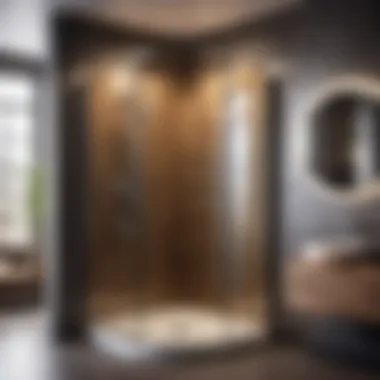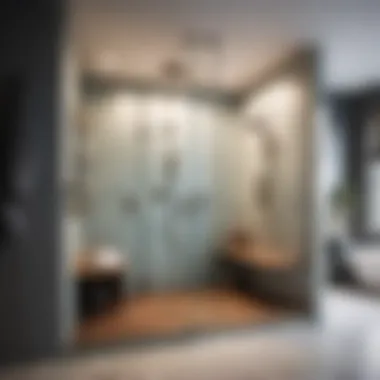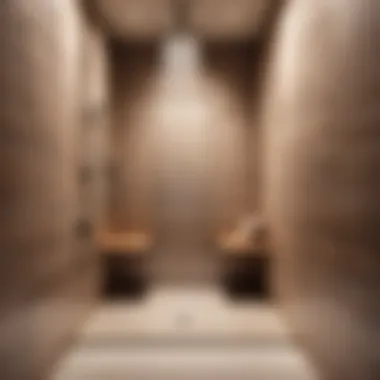Strategies for Efficiently Designing Handicap Showers in Compact Bathrooms


Materials:
- Handicap shower kit (specifically designed for small spaces) x1
- Waterproof adhesive/sealant x2 tubes
- Adjustable shower seat x1
- Grab bars x2
- Handheld showerhead with slide bar x1
- Non-slip shower mat x1
- Water-resistant shower curtain x1
- Waterproofing membrane x1 roll
DIY Steps:
- Measure and mark out the area in your bathroom where the handicap shower will be installed.
- Prepare the area by ensuring it is clean, dry, and free of any obstructions.
- Install the waterproofing membrane on the designated shower area following the manufacturer's instructions.
- Assemble the handicap shower kit according to the provided guidelines, ensuring all components fit snugly in the space.
- Apply waterproof adhesive/sealant around the edges of the shower base and walls to prevent leaks.
- Fix the shower seat securely to the wall at an appropriate height for comfortable use.
- Attach grab bars in strategic locations for added safety and support.
- Install the handheld showerhead with slide bar at a height suitable for users of varying heights.
- Place the non-slip shower mat inside the shower area to prevent slipping accidents.
- Hang the water-resistant shower curtain to contain water splashes and maintain cleanliness.
Technical Aspects:
- Tools required: Tape measure, drill, screwdriver, utility knife
- Timing specifics: Allow 1-2 days for complete installation depending on experience level
- Critical techniques: Proper waterproofing, secure fixture attachments, precise measurements
DIY Project Process:
- Begin by measuring accurately and planning the layout to optimize space efficiently.
- Proceed with the waterproofing process meticulously to prevent water damage in the long run.
- Carefully follow the assembly instructions of the shower kit to ensure a secure and functional installation.
- Pay special attention to attaching grab bars and the shower seat firmly to support weight and movement.
- Adjust the handheld showerhead height based on user needs for enhanced convenience.
- Regularly check for leaks and maintain the shower area clean and tidy for extended use.
Troubleshooting Tips:
- In case of leaks, reapply sealant around the affected area promptly.
- If fixtures feel loose, reinforce attachments or seek professional assistance.
- For slippery surfaces, invest in additional non-slip accessories for enhanced safety.
- Maintain regular maintenance checks to address minor issues before they escalate.
Introduction
Understanding the Need
Rising Demand for Handicap-Friendly Features
The rising demand for handicap-friendly features signifies a shift towards inclusive and universal design principles. Homeowners are increasingly seeking solutions that cater to individuals with diverse needs, embracing the concept of 'aging in place' and making their homes accessible to all. Handicap-friendly features offer not only practicality but also enhance the aesthetics of a space, making them a popular choice for modern bathroom designs. While these features may require initial investment, their long-term benefits in terms of functionality and inclusivity cannot be understated.
Challenges in Small Bathroom Design
Designing handicap showers in small bathrooms presents a unique set of challenges. Limited space constraints often make it difficult to balance functionality with style. However, with careful planning and strategic design choices, these challenges can be overcome. From ensuring adequate maneuvering space to selecting space-saving fixtures, addressing the inherent limitations of small bathrooms is essential to creating a seamless and accessible shower area.
Benefits of Handicap Showers
Enhanced Accessibility


Enhanced accessibility is a key benefit of incorporating handicap showers into small bathroom designs. With features like grab bars, non-slip flooring, and adjustable showerheads, these showers provide a safe and comfortable bathing experience for users of all ages and abilities. The thoughtful integration of accessibility features ensures that individuals with mobility limitations can navigate the space independently and with confidence.
Safety and Comfort
In addition to accessibility, safety and comfort are paramount considerations when optimizing handicap showers. Features such as foldable seats, anti-bacterial surfaces, and smart water management systems enhance both the safety and comfort levels of the shower area. By prioritizing these aspects, homeowners can create a relaxing and secure environment that promotes well-being and independence.
Objective of the Article
Exploring Design Solutions
One of the objectives of this article is to explore innovative design solutions for integrating handicap showers in small bathrooms. From space-saving layouts to customizable fixtures, there are numerous design possibilities that can enhance the accessibility and aesthetics of the shower area. By delving into these solutions, homeowners can gain insights into creating a functional and visually appealing bathroom space that meets their specific needs.
Maximizing Space Efficiency
Maximizing space efficiency is another key objective of this article. Small bathrooms require thoughtful space planning to optimize the available area effectively. By utilizing vertical space, incorporating dual-purpose fixtures, and prioritizing storage solutions, homeowners can make the most of limited square footage without compromising on the functionality or aesthetics of the bathroom. The focus on space efficiency aims to guide readers in creating a well-designed and practical shower area within the confines of a small bathroom.
Design Considerations
Design considerations play a pivotal role in the optimization of handicap showers for small bathrooms. Addressing the unique challenges presented by limited space and the need for accessibility, meticulous planning and thoughtful design choices are essential. By carefully considering layout, fixture placement, and utilization of vertical space, it is possible to create a functional and stylish bathroom that caters to the needs of all users.
Layout Optimization
Space Planning:
Space planning is a crucial aspect of designing a small bathroom to accommodate a handicap shower. It involves strategically organizing fixtures and layout to ensure efficient use of limited space. By prioritizing accessibility and ease of movement, space planning optimizes the functionality of the bathroom while maintaining a visually appealing design. The key characteristic of space planning lies in its ability to maximize usability without compromising on aesthetics. Its unique feature lies in its ability to create a harmonious flow within the bathroom, enhancing the overall user experience.
Accessible Fixture Placement:
Accessible fixture placement focuses on positioning shower fixtures and accessories in a way that enhances usability for individuals with mobility challenges. Placing fixtures within easy reach and ensuring sufficient maneuvering space are key considerations. This approach is a popular choice for this article as it aligns with the goal of optimizing accessibility without sacrificing style. By incorporating accessible fixture placement, the bathroom can be tailored to meet the specific needs of users, promoting independence and comfort.
Utilizing Vertical Space
Shelving and Storage Solutions:
Utilizing vertical space through shelving and storage solutions is a smart strategy for maximizing storage capacity in small bathrooms. By installing shelves and storage units vertically, valuable floor space is freed up, creating a more spacious feel. The key characteristic of this approach is its ability to provide ample storage without encroaching on the limited floor area. The unique feature of shelving and storage solutions lies in their versatility and ability to adapt to varying storage needs, offering customized organization options.


Showerhead Adjustability:
Adjustable showerheads offer flexibility in directing water flow, catering to the diverse needs of users. By allowing for height adjustment and different spray settings, showerhead adjustability enhances the shower experience for individuals of varying heights and abilities. The key characteristic of showerhead adjustability is its personalized functionality, enabling users to customize their showering experience. Its unique feature lies in its ability to accommodate users with specific preferences, promoting comfort and convenience.
Innovative Fixtures
Foldable Seats:
Foldable seats provide a practical seating solution for individuals who require support or rest while showering. Their foldable design allows for easy storage when not in use, optimizing space efficiency. The key characteristic of foldable seats is their dual functionality, serving as both a seating option and a space-saving fixture. The unique feature of foldable seats lies in their versatility and adaptability to different user needs, catering to comfort and accessibility.
Adjustable Grab Bars:
Adjustable grab bars offer stability and support for individuals with limited mobility, enhancing safety in the bathroom. Their adjustable feature allows for personalized positioning to suit individual requirements. The key characteristic of adjustable grab bars is their reliable assistance in preventing slips and falls, promoting independence and confidence. Their unique feature lies in their ability to blend seamlessly with the bathroom decor while providing essential support, ensuring both functionality and aesthetics throughout the space.
Aesthetics and Accessibility
Merge Function with Style
Sleek and Modern Design Elements
When it comes to sleek and modern design elements in handicap shower optimization, the focus is on clean lines, minimalist aesthetics, and contemporary finishes. Integrating sleek and modern design elements into the bathroom can elevate the overall look and feel of the space while ensuring it remains functional and accessible. The key characteristic of sleek and modern design elements is their ability to create a sense of sophistication and elegance within a limited space. Their popularity stems from their ability to provide a timeless and stylish appearance that transcends trends, making them a versatile choice for this article. The unique feature of sleek and modern design elements lies in their ability to streamline the bathroom layout, optimize visual space, and enhance the overall user experience. While they offer a sophisticated look, one potential disadvantage could be the higher cost associated with premium materials and finishes.
Color Palette Selection
Lighting and Ventilation
Natural Light Inclusion
Integrating natural light inclusion into the design of handicap showers in small bathrooms is essential for enhancing the aesthetics and accessibility of the space. Natural light not only brightens the area but also creates a sense of openness and warmth, making the bathroom feel more inviting and comfortable. The key characteristic of natural light inclusion is its ability to lift spirits, improve the visual appeal of the bathroom, and promote a sense of well-being. Its popularity stems from its eco-friendly nature and the ability to reduce reliance on artificial lighting, contributing to energy efficiency. A unique feature of natural light inclusion is its transformative effect on the atmosphere of the bathroom, creating a soothing and refreshing environment for users. However, a disadvantage could be the limited control over natural light levels and the need for supplemental lighting during darker hours.
Ventilation Solutions
Effective ventilation solutions are integral to optimizing handicap showers in small bathrooms. Proper ventilation not only removes excess moisture and odors but also helps maintain air quality and prevent mold and mildew growth. Choosing the right ventilation solution is essential for ensuring a comfortable and healthy bathroom environment for users. The key characteristic of ventilation solutions is their ability to promote air circulation, prevent humidity build-up, and enhance the longevity of fixtures and surfaces. Their popularity stems from their role in improving indoor air quality, reducing the risk of respiratory issues, and creating a pleasant bathing experience. A unique feature of ventilation solutions is their capacity to cater to various bathroom sizes and layouts while addressing specific ventilation needs. Despite their benefits in enhancing bathroom comfort, potential disadvantages may include installation costs and ongoing maintenance requirements.
Non-Slip Surfaces


Safety Flooring Options
Textured Tiles
Textured tiles are an integral component of optimizing handicap showers in small bathrooms, offering both aesthetic appeal and functional benefits. Textured tiles provide grip, prevent slippage, and enhance the tactile experience for users, particularly in wet areas like showers. The key characteristic of textured tiles lies in their ability to combine safety with style, offering a non-slip surface without compromising on visual aesthetics. Their popularity stems from their versatility in design applications, ability to create visual interest, and suitability for both modern and traditional bathroom settings. A unique feature of textured tiles is their tactile feedback, which adds a sensory dimension to the shower experience, providing a comfortable and secure surface for users. While advantageous in improving safety levels, potential disadvantages may include the need for regular cleaning to maintain the texture's effectiveness and the limited range of color and design options compared to traditional smooth tiles.
Technological Integration
Smart Solutions
Digital Controls
Digital controls are at the forefront of modern bathroom technology, offering precise control over water temperature, pressure, and flow. In the context of optimizing handicap showers, digital controls provide individuals with disabilities the ability to customize their shower experience to suit their specific needs. The key characteristic of digital controls lies in their intuitive interface, allowing users to adjust settings with ease. This feature is particularly beneficial for this article as it caters to individuals seeking a user-friendly and personalized shower experience. While the unique feature of digital controls lies in their programmable settings, some users may find the lack of physical knobs a disadvantage if they prefer traditional control methods.
Smart Water Management Systems
Smart water management systems are another integral component of modern bathroom technology. These systems enable users to monitor and regulate water usage efficiently, promoting sustainability and cost-effectiveness. In the context of handicap showers in small bathrooms, smart water management systems help to minimize excess water wastage, ensuring a more eco-friendly approach to showering. The key characteristic of these systems is their ability to track water usage in real-time, providing users with valuable insights for conservation. This article benefits from the inclusion of smart water management systems as it aligns with the overall goal of maximizing efficiency and resource utilization. The unique feature of these systems is their automatic shut-off function, which can be both advantageous in preventing water wastage and disadvantageous if users prefer continuous water flow for extended periods.
Voice-Activated Features
In a small bathroom setting with a focus on handicap accessibility, voice-activated features offer unparalleled convenience and ease of use. By integrating hands-free operation and accessibility enhancements, individuals with mobility challenges can enjoy a more independent and seamless showering experience.
Hands-Free Operation
Hands-free operation allows users to control various shower functions through voice commands or motion sensors, eliminating the need for manual adjustments. The key characteristic of hands-free operation lies in its ability to cater to individuals with limited dexterity or mobility, enabling them to operate the shower effortlessly. This feature is a popular choice for this article as it reflects the commitment to enhancing accessibility and user-friendliness. The unique feature of hands-free operation is its ability to adjust settings through customizable voice commands, offering a personalized showering experience. However, some users may find the need for consistent voice recognition a potential disadvantage.
Accessibility Enhancements
Accessibility enhancements encompass a range of features designed to make the showering experience more inclusive and accommodating for individuals with disabilities. These may include adjustable seat height, grab bars, and handheld showerheads. The key characteristic of accessibility enhancements is their focus on improving overall accessibility and user comfort, particularly for those with mobility challenges. This article benefits from accessibility enhancements as they align with the objective of creating a shower space that is safe, comfortable, and functional for all users. The unique feature of accessibility enhancements is their versatility in catering to various accessibility needs, yet some users may find the installation process or maintenance requirements challenging.
Innovative Materials
When optimizing handicap showers in small bathrooms, the selection of innovative materials plays a pivotal role in enhancing durability, hygiene, and aesthetics. Materials such as low-maintenance surfaces and those with anti-bacterial properties contribute significantly to the functionality and longevity of the shower space, ensuring a safe and hygienic environment for users.
Low-Maintenance Surfaces
Low-maintenance surfaces, such as composite materials or porcelain tiles, offer easy cleaning and upkeep, perfect for high-traffic areas like bathrooms. The key characteristic of low-maintenance surfaces is their resistance to stains, water damage, and mold growth, making them a popular choice for this article. Homeowners seeking a hassle-free and long-lasting solution will appreciate the durability and aesthetic appeal of these materials. The unique feature of low-maintenance surfaces is their seamless installation process, although some users may find the initial cost higher compared to standard materials.
Anti-Bacterial Properties
Materials with anti-bacterial properties are essential for maintaining a sanitary shower environment, especially in households with individuals with weakened immune systems. Anti-bacterial surfaces, ranging from tiles to shower fixtures, inhibit the growth of harmful bacteria and promote cleanliness. The key characteristic of materials with anti-bacterial properties is their ability to reduce the spread of germs, creating a healthier shower space for all users. This article benefits from highlighting these properties as it emphasizes the importance of hygiene and user well-being in a handicap-accessible shower. The unique feature of anti-bacterial properties is their long-lasting efficacy in preventing bacterial contamination, yet some users may find the limited choices in design or textures a drawback.







